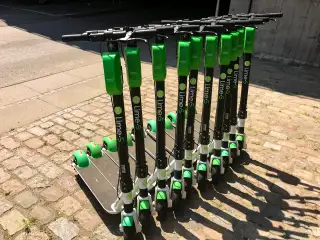Recharging Scooters for Lime and Bird Is a Hot New Side Gig. Here's How Much You Can Get Paid

Get your cords ready: "charging" is the latest gig economy position sweeping through big cities.
Electric scooter charging, that is. The independent contractors who collect, charge, and release electric Lime and Bird scooters back onto the streets can pocket up to hundreds of dollars a week.
Dockless electric scooters took off in the summer of 2018, mainly in California cities. A year later, the motorized scooters have quickly spread to cities through the U.S. and Europe. Like their bicycle-share predecessors, you use an app to reserve and pay for your scooter. But unlike the bike-share companies, you can leave the scooter wherever you like, instead of having to park it in a specific docking station.
That’s where chargers, or electric scooter "juicers," as they're known, come into the picture. They use the scooter service's app to locate scooters with a low charge and scan them. Then they scoop them up, take them home to plug them in, and finally drop them back off into high-demand neighborhoods. The blog Ridester reports Lime and Bird, two of the largest companies in the space, will pay about $5 per scooter recharge, and sometimes more depending on demand and ease of pick up. Lime has about 60,000 freelancers in its 100 cities, according to the New York Times.
Robert Cartwright, who charges for Bird, told the Times he could make $40,000 a year if he worked as a charger every day. He earns $6 for each scooter he recharges and drops off, as well as $2 for each move, in which he picks up scooters from far away locations and drives them to spots with higher customer demand.
Harry Campbell, founder of The Rideshare Guy blog, estimates you can earn $20 to $30 an hour as a Bird charger. Some "juicers" told the New York Times they make as much as $50 an hour.
Campbell and some of the chargers interviewed by the New York Times said one of the big benefits of the gig is that, unlike Uber, Lyft or Postmates, there's no customer interaction. The companies recommend you have a car to collect the scooters, though that doesn't seem to be strictly required. And there's little upfront cost, aside from purchasing the cords needed to charge the scooters. They run just $10 a piece, though you'll need multiple so you can charge multiple scooters at a time.
That doesn't mean the job is always a breeze. The scooters take hours to fully charge and you generally have to drop them back off in a designated area before 7 a.m. to get your full pay.
There can also be stiff competition to pick up the scooters. That means you might be hurrying to pick up a dead scooters that pops up on your app, only to arrive and see it being scooped up by another charger. And "hoarders" are apparently a big problem. Those are people who drive around picking up scooter regardless of whether they're dead. They stockpile them until their fee for pick-up increases or they need to be charged. (You can see an encounter with one of those hoarders here.)
Still, Bird founder and CEO Travis VanderZanden told Inc. last year that most scooter chargers enjoy the challenge.
"They like the money piece, but for them it's like a game of Pokémon Go," he said.